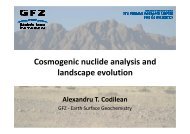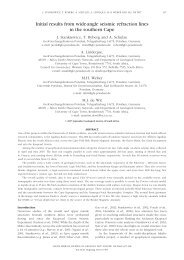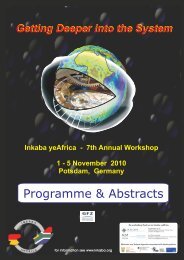Mandea et.al. - The magnetic field changing over
Mandea et.al. - The magnetic field changing over
Mandea et.al. - The magnetic field changing over
- TAGS
- mandea
- magnetic
- inkaba.org
Create successful ePaper yourself
Turn your PDF publications into a flip-book with our unique Google optimized e-Paper software.
196<br />
4a<br />
4b<br />
THE MAGNETIC FIELD CHANGING OVER THE SOUTHERN AFRICAN CONTINENT<br />
Figure 4 Tempor<strong>al</strong> evolution for the magn<strong>et</strong>ic <strong>field</strong> components: D (declination) H (horizont<strong>al</strong> component) and F (tot<strong>al</strong> <strong>field</strong> intensity) and<br />
their secular variation for eight repeat stations distributed <strong>over</strong> the southern African continent (see Figure 1 for their spati<strong>al</strong> distribution).<br />
<strong>The</strong>se three satellite datas<strong>et</strong>s have been used for<br />
computing various models based on satellite data only,<br />
or by combining satellite data with ground data.<br />
<strong>The</strong> intern<strong>al</strong> part of the geomagn<strong>et</strong>ic <strong>field</strong> is gener<strong>al</strong>ly<br />
described mathematic<strong>al</strong>ly by a spheric<strong>al</strong> harmonic<br />
expansion. This is the representation of the magn<strong>et</strong>ic<br />
<strong>field</strong> potenti<strong>al</strong> as a series of multipoles: n=1 represents<br />
the dipole contribution, n=2 that from a quadrupole, n=3<br />
SOUTH AFRICAN JOURNAL OF GEOLOGY<br />
from octopole and so on. <strong>The</strong> degrees thus are a<br />
measure for spati<strong>al</strong> wavelength. At sm<strong>al</strong>ler degrees the<br />
<strong>field</strong> from the core is dominant. B<strong>et</strong>ween approximately<br />
degrees n=13 and 15, or 3000 to 2600 km wavelength,<br />
the observed <strong>field</strong> is strongly influenced by both core<br />
and lithospheric <strong>field</strong> contributions. For degrees larger<br />
than n=15, the short wavelengths of the core <strong>field</strong> are<br />
masked by the lithospheric sign<strong>al</strong>, and the long









